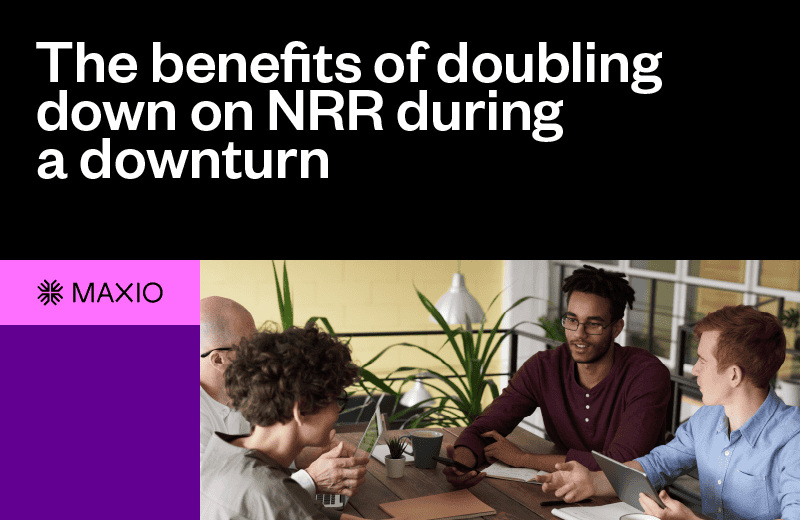During a downturn, Net Revenue Retention (NRR) becomes even more important as SaaS companies are typically seeing fewer bookings, less new customers, and higher levels of churn. Unless you’ve got plenty of capital to burn, you need to focus on reducing churn and doubling down on expansion revenue instead of new logo acquisition.
By using NRR as a benchmark for success, SaaS leaders can rely on the loyalty of existing customers (in the form of renewals and expansion revenue) to weather the market downturn until business picks back up.
How can you go about managing and measuring this relevant retention metric? Let’s take a look.
What is Net Revenue Retention (NRR)?
SaaS net revenue retention is an essential SaaS metric that measures the percentage of recurring revenue from customers in a given period that is still being paid after twelve months. In other words, it’s a measure of customer loyalty.
NRR is also looked at favorably by board members and investors because it’s a leading indicator of growth. In order to grow revenue, companies need to first retain their existing customers and then expand their business with those customers by upselling and cross-selling additional products and services.
Higher SaaS net revenue retention means less churn, greater expansion revenue, and a better shot at surviving a downturn.
How to calculate Net Revenue Retention (NRR)
Calculating your company’s net revenue retention is relatively simple. First, you need to identify the total amount of revenue generated in a given period (P1). Then, add any expansion revenue generated in P1, and subtract it by churned revenue in that period. Finally, take all the variables included in P1 and divide them by your starting ARR/MRR in period two (P2).
NRR = ((MRR at Start of Month Expansion MRR) – (Churn MRR Contraction MRR)) ÷ (MRR Start of Month) × 100%
It’s important to note you can calculate net revenue retention for any period of time—monthly, quarterly, annually, etc. The longer the time frame, the more accurate your calculation will be. For example, if you only looked at one month of data, outliers in customer behavior are more likely to distort your results. However, if you looked at net retention over the course of the year, those fluctuations would even out, giving you a more accurate picture of your company’s overall performance.
How to improve your Net Revenue Retention Rate
Improving your NRR is pretty straightforward. After all, you only have to worry about two variables: churn and expansion revenue (cross-sells and upsells). But to see actionable progress with these metrics, you need to get all your GTM teams aligned on this common goal. Here are a few ways your GTM teams can work together to improve NRR.
1. Set goals around customer retention
Setting goals around retention will give your Customer Success and other GTM teams the direction they need to retain existing customers. To start, you can base your initial retention goals on your current churn rate. In an ideal world, none of your customers will churn, so your retention goals should offset whatever your current churn rate is. However, some of this churn will also be offset by expansion revenue too. If possible, your retention rates and expansion revenue should combine to equal a NRR rate of 100% (or higher) to avoid any loss of revenue.
2. Monitor your customer health scores by vertical
Most Customer Success teams use ‘customer health scores’ to determine how likely a target account is to churn, renew, or purchase additional add-ons. These scores weigh both quantitative and qualitative buying signals, such as service utilization, product usage, engagement, satisfaction, and support history. By monitoring your customer health scores, you can take appropriate action to prioritize service for at-risk accounts or pursue upsell and cross-sell opportunities with successful customers.
3. Deploy a usage-based pricing strategy
Deploying usage-based pricing (UBP) to increase NRR will give you several clear advantages over your competitors. First, usage-based pricing aligns your pricing with the products and services your customers care about. In other words, instead of churning, customers can reduce or reallocate their spending to use the core features of your SaaS that provide them with the greatest value.
Additionally, SaaS companies deploying UBP incur no additional costs from sales or marketing spend. Through UBP, you can worry less about driving up your CAC while trying to win new business during an impending recession, and instead focus on monetizing the products and services that make up the core of your business.
Using Maxio to measure NRR
Ever heard the phrase “you can’t manage what you can’t measure?” The same rule applies when it comes to measuring net revenue retention.
With Maxio, you can:
- Track NRR by customer cohorts to identify trends in churn, downgrades, and upgrades
- Reevaluate individual business segments and product lines to see how they’re contributing to revenue expansion
- Determine which of your existing customers have the highest LTV
Want more proven strategies to help you navigate the market downturn unscathed? Check out our ebook, Scaling During a Recession: Winning Strategies for SaaS Leaders.

